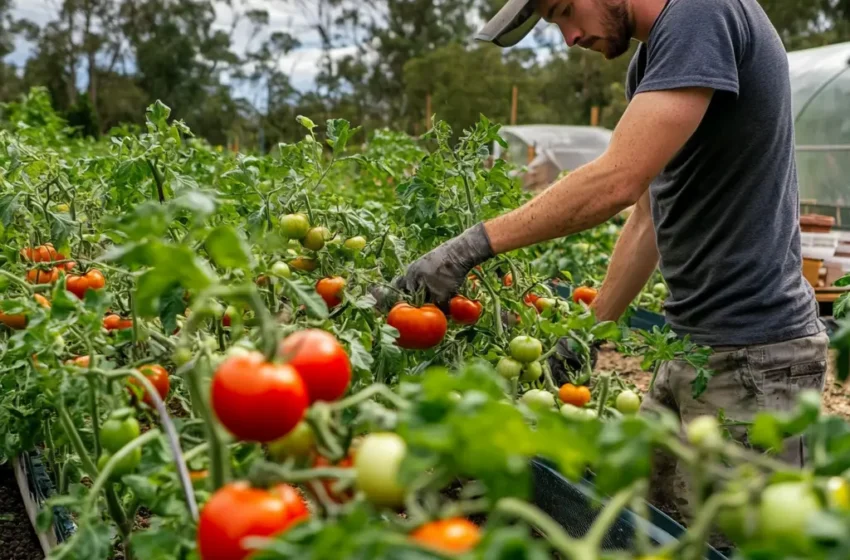Kyle Turner: The Rabbitohs legend who never forgot his roots

How to grow tomatoes successfully in Australia
Tomatoes are one of the most popular homegrown vegetables in Australia—and for good reason. They’re easy to grow, highly versatile in cooking, and taste significantly better when homegrown than store-bought. Whether you’re a seasoned green thumb or a complete beginner, learning how to grow tomatoes can be both rewarding and budget-friendly.
This article will walk you through the essential steps to grow tomatoes in Australian conditions, from selecting the right variety to harvesting your juicy produce.
1. Choose the right tomato variety
Tomatoes come in multiple shapes, sizes, and growth patterns. Selecting the right variety for your needs and environment is crucial for success. Among the most often used categories are:
- Cherry tomatoes – Perfect for small spaces and container gardening. They are fast-growing and ideal for salads and appetisers.
- Roma tomatoes – They are grateful for their rectangular, firm flesh is ideal for sauces, pastes, and preservation.
- Beefsteak tomatoes – Perfect for sandwiches and slicing, beefsteak tomatoes are mouthfuls.
- Heirloom varieties – Though they usually call for greater care and disease control, heirloom varieties offer distinctive flavours, hues, and forms.
Consider your environment and tolerance to common pests and illnesses before choosing a cultivar.
2. Pick the perfect planting spot
Tomatoes need at least 6 to 8 hours of daily sunlight. Excellent ventilation and a well-lit environment will help to combat diseases and support excellent development. Put them in containers so they will be most exposed to sunlight.
3. Prepare the soil properly
Growing vigorous tomato plants requires ground with high nutrient density. As such, get your ground ready:
- Work with a loamy, well-drained soil heavy in organic components.
- To improve soil fertility, add aged compost or manure.
- Look for the ph of the soil; it should lie between 6.0 and 6.8.
- Mulch will help you suppress weeds and hold moisture.
Use quality vegetable-oriented potting mix if you are growing in pots.
4. Plant at the right time
Tomato development relies a lot on proper timing. After the frost risk passes, tomatoes are produced all over Australia in the spring and early summer. Autumn planting makes sense in warmer climates as well. If your temperature is cold, consider starting seeds indoors and then moving them outside when temperatures rise.
5. Space and support your plants
Accurate spacing reduces illness risk and improves airflow. Abide by these rules:
- Space plants 40 to 60 cm apart.
- Trellises, cages, or poles will help branches keep from breaking under fruit weight.
- To minimise damage, gently tie knots connecting plants to stakes.
Supporting your tomatoes reduces the rot and pest danger and helps to keep the fruit off the ground.
6. Water consistently but avoid overwatering
Good tomato plants depend on the right hydration.
- Deeply 2 to 3 times a week, water to ensure the root system absorbs moisture.
- Avoid overhead irrigation to prevent blight and other fungal diseases.
- Mulch helps to maintain soil temperature and holds moisture.
- If at all possible, choose drip irrigation to provide a constant water supply.
The secret is consistency; uneven watering can lead to issues, including blossom end rot and cracking.
7. Fertilise for optimal growth
Tomatoes need correct fertilisation and are heavy feeders.
- Using a balanced fertiliser strong in potassium and phosphate helps one promote flowering and fruiting.
- Cut back on too much nitrogen; it promotes leaf development at the expense of fruit.
- To provide extra nutrients, add a liquid seaweed or fish emulsion fertiliser every few weeks.
- Garden lime or broken eggshells help give calcium and fight blossom end rot.
8. Prune and remove suckers
Regular pruning improves fruit output and keeps plants healthy.
- Remove suckers, little sprouts develop between branches and the main stem.
- Cut the lower leaves to increase airflow and reduce the fungal infection.
- Usually, trim off any additional growth to keep indeterminate plants under control.
9. Protect against pests and diseases
Tomato diseases and bugs abound. The guidelines above help one to manage and avoid them:
- Common pests: Aphids, whiteflies, and caterpillars can all damage tomato plants. Bring in useful bugs like ladybirds or use organic insecticides like neem oil.
- Fungal diseases: Early blight, late blight, and powdery mildew can affect tomatoes. Prevent them by ensuring good airflow, avoiding overhead watering, and using fungicidal sprays if needed.
- Companion planting: Grow astrotiums, marigolds, and basil next to naturally occurring insect control.
Look for signs of difficulty in plants; if problems arise, act fast.
10. Harvest at the right time
Taste-wise, tomatoes cultivated on a vine are better. When and how should one choose them?
- Choose coloured tomatoes with just a mild touch of hardness.
- Harvest green tomatoes and, should frost be forecast, let them ripen indoors.
- Fresh tomatoes should not be kept refrigerated since they lose taste and texture.
Mix early, mid-season, and late-season varieties for continuous output.
Additional tips for a bumper tomato crop
- Rotate crops each year to prevent soil depletion and disease buildup.
- Use shade cloth if temperatures exceed 30°C, as excessive heat can reduce fruit production.
- Lightly shake flowers or grow pollinator-attracting plants nearby to aid pollination.
- Extend the growing season with a greenhouse in cooler climates.
- Save seeds from your best crops for future planting.
Conclusion
Growing tomatoes is a rewarding hobby that yields delicious, fresh produce far superior in taste to supermarket alternatives. By choosing the right variety, preparing the soil correctly, and maintaining consistent watering and fertilising practices, you’ll enjoy a successful tomato garden. With proper pest control, pruning, and harvesting techniques, you’ll be well on your way to a season full of sun-ripened, home-grown tomatoes.
Happy gardening!
Read also: What is hybrid flooring and why it’s trending in Australia?

